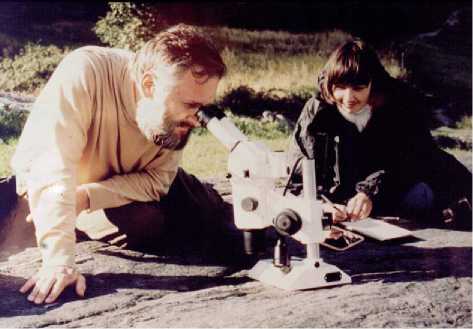One of the priorities in contemporary rock art research is the development of methods for estimating the age of rock art motifs. During the 1980s, this led to the replacement of stylistic or iconographic dating by forms of ‘direct dating’, in which the age of dating criteria physically and directly related to the rock art is determined. Propositions of the chronological relationship of these criteria with the rock art must be testable, that is, refutable. The dating criterion may be of the same age as the rock art (e. g., an organic binder contained in the paint residue of a pictogram, or the fracture surfaces caused by the impact that occurred when a petroglyph was made); or it may be older than the rock art (e. g., its support surface, or a lichen thallus dissected by an engraved line); or it may be younger than the rock art (e. g., a superimposed insect nest, or a mineral accretion concealing the art). There are numerous types of such directly relatable criteria, most of which have been provided by geochemistry so far. However, direct dating offers no actual ages of rock art; it merely generates testable propositions about the relevance of specific physical or chemical data to the true age of rock art. The interpretation of this relationship demands an understanding of the method used, of the circumstances of sample collection, and of the limitations applying to stated results. The principal difficulty experienced with this approach is that the interpretation of its results is usually contingent on such complex qualifications that they are difficult to relate to immediate concerns of archaeology. To practitioners seeking certainties, expressions of probabilities or intricate formulations of explanatory scenarios are frustrating and seem to limit the practical use of such data.
The first method used in this quest was radiocarbon analysis of mineral accretions containing atmospheric carbon, such as carbonates and oxalates. These are often found in direct physical relation with rock art, but the utility of their results is limited by a complex set of qualifications. Uranium-series Dating (thorium-uranium) has also been applied to carbonate. Most widely used has been the carbon-isotope analysis of inclusions in mineral accretions or in paint residues, and the determination of the age of charcoal pigments. Here, the qualifications are somewhat simpler. In the former method, the principal limitation is that, to obtain valid estimates, the nature of the analyzed substance must be determined, either at the object or molecular level. Until recently, all such determinations referred to bulk samples, but in 2005, an Italian team succeeded in isolating the dated substance molecularly in rock paintings at five Libyan sites.
The determination of carbon ages of charcoal pic-tograms is a straightforward method, but unfortunately, the date refers to the time when the tree in question assimilated carbon from the atmosphere, not to the time of rock art production. Ancient charcoal might have been used in this, and often was, which introduces an obvious limitation to such results. The most reliable results from any pictograms so far are 137 carbon isotope determinations obtained from beeswax figures in Northern Australia. An experimental approach is to use sand grains embedded in wasp or termite nests directly related to rock art to determine when they were last exposed to light, using the optically stimulated luminescence method.
Petroglyphs may be more difficult to date than paintings, because they offer no substance relating to the time of their execution. The mineral dust then yielded is probably not recoverable. Nevertheless, the surfaces freshly exposed and the mineral crystals broken or truncated at that time experience significant changes over time, which are utilized in microerosion analysis. Two forms of this method have been used so far: the determination of erosion on rocks with components that weather at very different rates and the measurement of micro-wanes on fractured mineral crystals. The second version is the more developed, but its use is limited to very erosion-resistant rock types containing crystalline quartz, such as granite, whereas sedimentary rocks are usually unsuitable (Figure 2). A very robust analytical method, microerosion analysis yields reliable dates for petroglyphs manufacture, but they are typically imprecise and several preconditions need to be met. Recently, digital colorimetry has been applied to both repatinated petroglyphs and pictogram, after surprisingly consistent results were secured from historical inscriptions of known ages. Other approaches, so far not effectively applied, would be to use lichenometry or rock surface retreat for estimating the ages of petroglyphs, or the use of weathering zone growth rates and

Figure 2 Microerosion analysis of Neolithic petroglyph at Rupe Magna, Valtellina, northern Italy. Photograph by R. G. Bednarik.
Macro-wanes. There is thus considerable scope for extending the range of viable direct dating methods.
While the scientific study of rock art may still be in its infancy, it is not limited to issues of antiquity. Investigations of the technology of rock art have involved several productive approaches, including the study of the tools used in making petroglyphs, of paint recipes, of microscopic inclusions found in paint residues, and of the sourcing of pigment materials. Nanostratigraphy - the microscopic excavation of strata of paint residues, mineral accretions or weathering and patination zones - was first introduced in the 1970s, and has been developed to great sophistication already. Its principles are rather similar to those of archaeological stratigraphy, but its methods, obviously, are very different. To some extent, this method might even overcome the limitation of rock art being, in contrast to archaeological sediment strata, apparently two dimensional. This potential is well shown by Alan Watchman’s extraction of ten radiocarbon ages from a stratigraphical sequence of pigments and mineral deposits totaling only 2.11mm thickness, in north Queensland. The results were all in sequence, covering a period of 26 000 carbon years.
Various other issues have been explored by rock art science in recent decades, such as the establishment of criteria for the effective discrimination between human-made rock marks and natural markings on rocks. This had been a major problem in archaeology, with hundreds of cases of misidentification of both types of rock markings. Most of these mistakes refer to petroglyphs and natural markings resembling them, but there are also a few prominent cases of pictograms on record. One of the most promising areas of scientific investigation of rock art concerns the holistic analysis of its physical, cultural, and cognitive contexts. This includes the examination, often by field microscopy, of traces related to the production of rock markings, especially in well-preserved condition (particularly in caves). The methods used closely resemble those of forensic science (matching of microscopic striae, identification of microscopic organic traces, and so forth), and are designed to determine the gestures involved in making the rock art. Their results can be correlated with other evidence in the same context (e. g., subterranean mining of flint and possible medicinal use of speleothems, probable indications of ritualistic behavior; some examples of the latter are the intentional placing of cave bear bones or other objects, or the systematic marking of cave walls by deliberate activities not yielding rock art).
Recently, a trend has become evident to explore the cultural and cognitive development of humans through rock art, especially of the Pleistocene period. Cognitive evolution, informed by advances in neuroscience anD psychology, is increasingly becoming relevant to the understanding of the earliest art. Pleistocene rock art and portable art-like productions can provide evidence that may help test particular models as to how human cognition may have eventuated. As research into cognition and neuroscience continues apace, rock art and other palaeoart become primary data sources for it. Underlying principles and uni-versals need to be identified, and the material of the Middle and Early Upper Pleistocene requires much more attention than has been evident in the twentieth century. This reflects another change from traditional preoccupations to new approaches. It will endeavor to place Pleistocene palaeoart into the context of cognitive evolution, explore its semiotic dimensions, and consider implications for technology and culture during the Palaeolithic period.




 World History
World History









